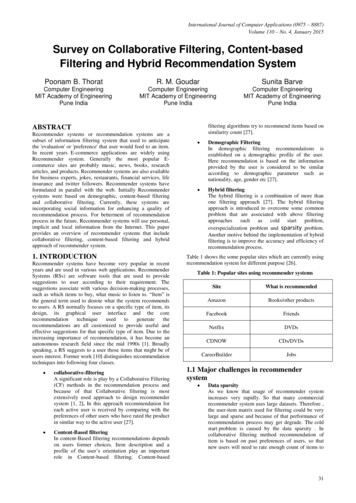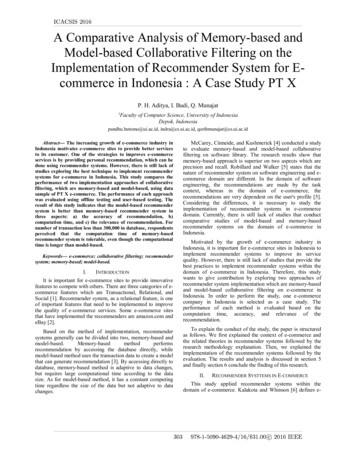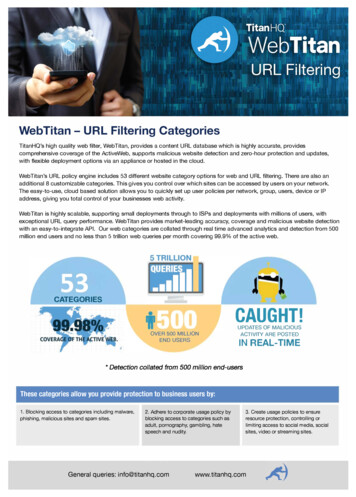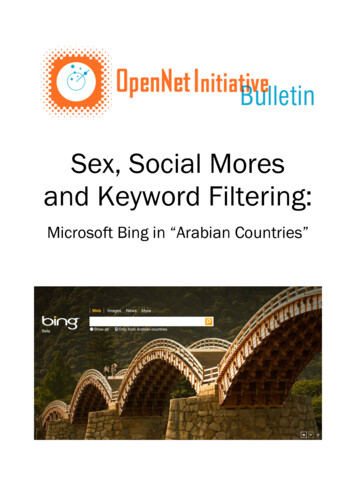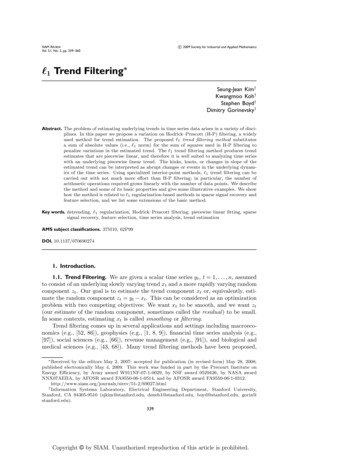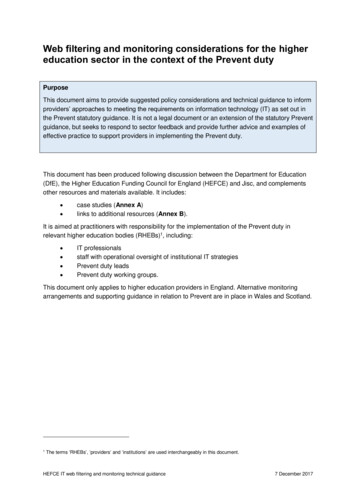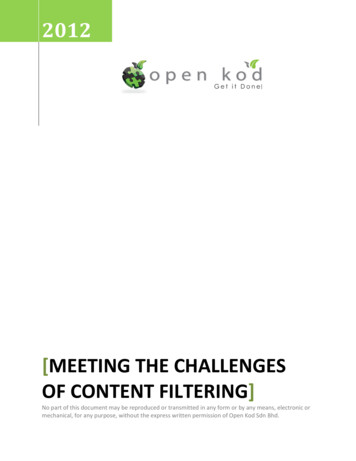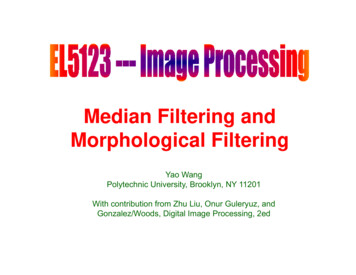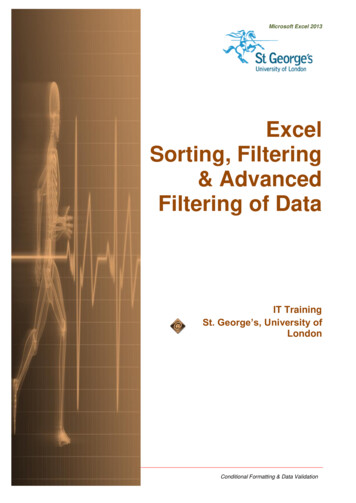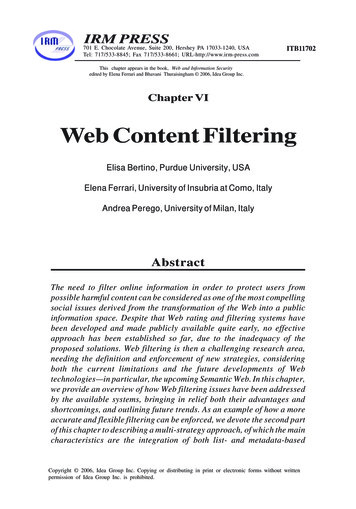
Transcription
112 Bertino, Ferrari, and PeregoIRM PRESS701 E. Chocolate Avenue, Suite 200, Hershey PA 17033-1240, USATel: 717/533-8845; Fax 717/533-8661; URL-http://www.irm-press.comITB11702This chapter appears in the book, Web and Information Securityedited by Elena Ferrari and Bhavani Thuraisingham 2006, Idea Group Inc.Chapter VIWeb Content FilteringElisa Bertino, Purdue University, USAElena Ferrari, University of Insubria at Como, ItalyAndrea Perego, University of Milan, ItalyAbstractThe need to filter online information in order to protect users frompossible harmful content can be considered as one of the most compellingsocial issues derived from the transformation of the Web into a publicinformation space. Despite that Web rating and filtering systems havebeen developed and made publicly available quite early, no effectiveapproach has been established so far, due to the inadequacy of theproposed solutions. Web filtering is then a challenging research area,needing the definition and enforcement of new strategies, consideringboth the current limitations and the future developments of Webtechnologies—in particular, the upcoming Semantic Web. In this chapter,we provide an overview of how Web filtering issues have been addressedby the available systems, bringing in relief both their advantages andshortcomings, and outlining future trends. As an example of how a moreaccurate and flexible filtering can be enforced, we devote the second partof this chapter to describing a multi-strategy approach, of which the maincharacteristics are the integration of both list- and metadata-basedCopyright 2006, Idea Group Inc. Copying or distributing in print or electronic forms without writtenpermission of Idea Group Inc. is prohibited.
Web Content Filtering 113techniques and the adoption of sophisticated metadata schemes (e.g.,conceptual hierarchies and ontologies) for describing both users’characteristics and Web pages content.IntroductionIn its general meaning, information filtering concerns processing a given amountof data in order to return only those satisfying given parameters. Although thisnotion precedes the birth of the Internet, the success and spread of Internetbased services, such as e-mail and the Web, resulted in the need of regulatingand controlling the network traffic and preventing the access, transmission, anddelivery of undesirable information.Currently, information filtering is applied to several levels and services of theTCP/IP architecture. Two typical examples are spam and firewall filtering. Theadopted strategies are various, and they grant, in most cases, an efficient andeffective service. Yet, the filtering of online multimedia data (text, images,video, and audio) is still a challenging issue when the evaluation of their semanticmeaning is required in order to verify whether they satisfy given requirements.The reason is that the available techniques do not allow an accurate and preciserepresentation of multimedia content. For services like search engines, thisresults in a great amount of useless information returned as a result of a query.The problem is much more serious when we need to prevent users fromretrieving resources with given content (e.g., because a user does not have therights to access it or because the content is inappropriate for the requestinguser). In such a case, filtering must rely on a thorough resource description inorder to evaluate it correctly.The development of the Semantic Web, along with the adoption of standardssuch as MPEG-7 (TCSVT, 2001) and MPEG-21 (Burnett et al., 2003), mayseemingly overcome these problems in the future. Nonetheless, currently onlineinformation is unstructured or, in the best case, semi-structured, and this is notsupposed to change in the next few years. Thus, we need to investigate how andto what extent the available techniques can be improved to allow an effectiveand accurate filtering of multimedia data.In this chapter, we focus on filtering applied to Web resources in order to avoidpossibly harmful content accessed by users. In the literature, this is usuallyCopyright 2006, Idea Group Inc. Copying or distributing in print or electronic forms without writtenpermission of Idea Group Inc. is prohibited.
114 Bertino, Ferrari, and Peregoreferred to as Internet filtering, since it was the first example of informationfiltering on the Internet with relevant social entailments—that is, the need toprotect given categories of users (e.g., children) from Web content not suitablefor them. The expression is misleading since it could apply also to Internetservices like spam and firewall filtering, already mentioned above. Moreproperly, it should be called Web filtering, and so we do henceforth.Web filtering is a rather challenging issue, the requirements of which have notbeen thoroughly addressed so far. More precisely, the available Web filteringsystems focus on two main objectives: protection and performance. On onehand, filtering must prevent at all costs harmful information from being accessed—that is, it is preferable to block suitable content rather than allowingunsuitable content to be displayed. On the other hand, the filtering proceduremust not noticeably affect the response delay time—that is, the evaluation of anaccess request and the returned result must be quickly performed.Such restrictive requirements are unquestionably the most important in Webfiltering since they grant effectiveness with respect to both user protection andcontent accessibility. Yet, this has resulted in supporting the rating of resourcecontent and users’ characteristics which is semantically poor. In most cases,resources are classified into a very small set of content categories, whereas onlyone user profile is provided. The reason is twofold. On one hand, as alreadymentioned above, the way Web information is encoded and the availableindexing techniques do not allow us to accurately rate Web pages with theprecision needed to filter inappropriate content. On the other hand, a richsemantic description would require high computational costs, and, consequently, the time needed to perform request evaluation would reduce information accessibility. These issues cannot be neglected, but we should not refrainfrom trying to improve flexibility and accuracy in rating and evaluating Webcontent. Such features are required in order to make filtering suitable todifferent user’s requirements, unlike the available systems which have ratherlimited applications.In the remainder of this chapter, besides providing a survey of the state-of-theart, we propose extensions to Web filtering which aim to overcome the currentdrawbacks. In particular, we describe a multi-strategy approach, formerlydeveloped in the framework of the EU project EUFORBIA,1 which integratesthe available techniques and focuses on the use of metadata for rating andfiltering Web information.Copyright 2006, Idea Group Inc. Copying or distributing in print or electronic forms without writtenpermission of Idea Group Inc. is prohibited.
Web Content Filtering 115Web Rating and Filtering ApproachesWeb filtering concerns preventing users from accessing Web resources withinappropriate content. As such, it has become a pressing need for governmentsand institutional users because of the enormous growth of the Web during thelast 10 years and the large variety of users who have access to and make useof it. In this context, even though its main aim is minors’ protection from harmfulonline contents (e.g., pedophilia, pornography, and violence), Web filtering hasbeen and still is considered by institutional users—for instance, firms, libraries,and schools—as a means to avoid the improper use of their network servicesand resources.Web filtering entails two main issues: rating and filtering. Rating concerns theclassification (and, possibly, the labeling) of Web sites content with respect toa filtering point of view, and it may be carried out manually or automatically,either by third-party organizations (third-party rating) or by Web site ownersthemselves (self-rating). Web site rating is not usually performed on the fly asan access request is submitted since it would dramatically increase the responsetime. The filtering issue is enforced by filtering systems, which are mechanismsable to manage access requests to Web sites, and to allow or deny access toonline documents on the basis of a given set of policies, denoting which userscan or cannot access which online content and the ratings associated with therequested Web resource. Filtering systems may be either client- or serverbased and make use of a variety of filtering techniques.Currently, filtering services are provided by ISP, ICT companies, and nonprofit organizations, which rate Web sites and make various filtering systemsavailable to users. According to the most commonly used strategy—which werefer to as the traditional strategy in what follows—Web sites are ratedmanually or automatically (by using, for instance, neural network-basedtechniques) and classified into a predefined set of categories. Service subscribers can then select which Web site categories they do not want to access. Inorder to simplify this task, filtering services often provide customized access tothe Web, according to which some Web site categories are consideredinappropriate by default for certain user categories. This principle is alsoadopted by some search engines (such as Google SafeSearch) which returnonly Web sites belonging to categories considered appropriate.Another rating strategy is to attach a label to Web sites consisting of somemetadata describing their content. This approach is adopted mainly by PICS-Copyright 2006, Idea Group Inc. Copying or distributing in print or electronic forms without writtenpermission of Idea Group Inc. is prohibited.
116 Bertino, Ferrari, and Peregobased filtering systems (Resnick & Miller, 1996). PICS (Platform for InternetContent Selection) is a standard of the World Wide Web Consortium (W3C)which specifies a general format for content labels. A PICS content labeldescribes a Web page along one or more dimensions by means of a set ofcategory-value pairs, referred to as ratings. PICS does not specify anylabeling vocabulary: this task is carried out by rating or labeling services,which can specify their own set of PICS-compliant ratings. The filtering task isenforced by tools running on the client machine, often implemented in the Webbrowser (e.g., both Microsoft Internet Explorer and Netscape Navigatorsupport such filters).2Compared to the category models used in the traditional strategy, PICS-basedrating systems are semantically richer. For instance, the most commonly usedand sophisticated PICS-compliant rating system, developed by ICRA (InternetContent Rating Association: www.icra.org), provides 45 ratings, grouped intofive different macro-categories: chat, language, nudity and sexual material,other topics (promotion of tobacco, alcohol, drugs and weapons use, gambling, etc.), violence.3 On the other side, the category model used byRuleSpace EATK , a tool adopted by Yahoo and other ISPs for theirparental control services, makes use of 31 Web site categories.4On the basis of the adopted filtering strategies, filtering systems can then beclassified into two groups: indirect and direct filtering. According to theformer strategy, filtering is performed by evaluating Web site ratings stored inrepositories. These systems are mainly based on white and black lists,specifying sets of good and bad Web sites, identified by their URLs. It is theapproach adopted by traditional filtering systems. The same principle isenforced by the services known as walled gardens, according to which thefiltering system allows users to navigate only through a collection of preselectedgood Web sites. Rating is carried out according to the third-party ratingapproach.Direct filtering is performed by evaluating Web pages with respect to theiractual content, or the metadata associated with them. These systems use twodifferent technologies. Keyword blocking prevents sites that contain any of alist of banned words from being accessed by users. Keyword blocking isunanimously considered the most ineffective content-based technique, and it iscurrently provided as a tool which can be enabled or disabled by user’sdiscretion. PICS-based filtering verifies whether an access to a Web page canbe granted or not by evaluating (a) the content description provided in the PICSlabel possibly associated with the Web page and (b) the filtering policiesCopyright 2006, Idea Group Inc. Copying or distributing in print or electronic forms without writtenpermission of Idea Group Inc. is prohibited.
Web Content Filtering 117specified by the user or a supervisor. PICS-based filtering services adopt aself-rating approach, usually providing an online form which allows Web siteowners to automatically generate a PICS label.According to analyses carried out by experts during the last years,5 bothindirect and direct filtering techniques have several drawbacks, which can besummarized by the fact that they over- or under-block. Moreover, bothcategory models adopted by traditional rating services and PICS-based ratingsystems have been criticized for being too Western-centric so that theirservices are not suitable for users with a different cultural background. Thoseanalyses make clear that each filtering technique may be suitable (only) forcertain categories of users. For instance, though white and black lists grant avery limited access to the Web, which is not suitable for all users, thesetechniques, and especially walled garden-based services, are considered as thesafest for children.The available PICS-based rating and filtering services share similar drawbacks. The content description they provide is semantically poor: for instance,none of them makes use of ontologies, which would allow a more accuratecontent description. Moreover, it is limited to content domains consideredliable to be filtered according to the Western system of values. Nevertheless,the PICS standard can be considered, among the available technologies, theone which can better address the filtering issues. Since its release in 1996,several improvements have been proposed, first of all, the definition of a formallanguage for PICS-compliant filtering rules, referred to as PICSRules (W3C,1997). Such a language makes the task of specifying filtering policies accordingto user profiles easier, and it could be employed by user agents to automaticallytailor the navigation of users. Finally, in 2000, the W3C proposed an RDFimplementation of PICS (W3C, 2000), which provides a more expressivedescription of Web sites content, thus enabling more sophisticated filtering.Despite these advantages, the PICS-based approach is the less diffused. Thereason is that it requires Web sites to be associated with content labels, butcurrently, only a very small part of the Web is rated. PICS-based services, likeICRA, have made several efforts to establish the practice of self-rating amongcontent providers, but no relevant results have been obtained. Moreover, boththe PICS extensions mentioned above (PICSRules and PICS/RDF) did not gobeyond the stage of proposal. Nonetheless, the wider and wider use of XMLand its semantic extensions—that is, RDF (W3C, 2004b) and OWL (W3C,2004a)—make metadata-based approaches the major research issue in thefiltering domain. Consequently, any improvement in Web filtering must take intoCopyright 2006, Idea Group Inc. Copying or distributing in print or electronic forms without writtenpermission of Idea Group Inc. is prohibited.
118 Bertino, Ferrari, and Peregoconsideration both the current limitations and the future developments of Webtechnologies.So far, we have considered how the rating and filtering issues have beenaddressed with respect to the object of a request (Web sites). Yet, whichcontent is appropriate or inappropriate for a user depends on his/her characteristics—that is, access to a given Web site can be granted or preventeddepending on the requesting user. Consequently, filtering may be considered asa process entailing the evaluation of both subjects (users) and objects (Websites) properties. The simplest case is when users share the same characteristics: since only a single user profile is supported, the filtering parameters areset by default, and there is no need to evaluate the characteristics of a singleuser. This applies also when we have one or more predefined user profiles orwhen filtering policies concern specific users. Such an approach, which werefer to as static user profiling, is the one adopted by the available filteringsystems, and it has the advantage of simplifying the evaluation procedure (onlyWeb sites characteristics must be evaluated), which reduces the computationalcosts. On the other hand, it does not allow flexibility; thus, it is not suitable indomains where such a feature is required.Following, we describe a filtering approach which aims at improving, extending, and making more flexible the available techniques by enforcing two mainprinciples: (a) support should be provided to the different rating and filteringtechniques (both indirect and direct), so they can be used individually or incombination according to users’ needs and (b) users’ characteristics must bedescribed accurately in order to provide a more effective and flexible filtering.Starting from these principles, we have defined a formal model for Webfiltering. The objective we pursued was to design a general filtering framework,addressing both the flexibility and protection issues, which can possibly becustomized according to users’ needs by using only a subset of its features.Multi-Strategy Web FilteringIn our model, users and Web pages (resources, in the following) are consideredas entities involved in a communication process, characterized by a set ofproperties and denoted by an identifier (i.e., a URI). A filtering policy is a rule,stating which users can/cannot access which resources. The users and re-Copyright 2006, Idea Group Inc. Copying or distributing in print or electronic forms without writtenpermission of Idea Group Inc. is prohibited.
Web Content Filtering 119sources to which a policy applies are denoted either explicitly by specifyingtheir identifiers, or implicitly by specifying constraints on their properties (e.g.,“all the users whose age is less than 16 cannot access resources withpornographic content”). Note that the two types of user/resource specifications (explicit and implicit) are abstractions of the adopted filtering strategies:explicit specifications correspond to list-based approaches (i.e., white/blacklists and walled gardens); implicit specifications merge all the strategies basedon ratings (e.g., PICS) and/or content categories (e.g., RuleSpace).Users’ and resources properties are represented by using one or more ratingsystems. Since rating systems are organized into different data structures, andsupport should be provided to more complex and semantically rich ones (e.g.,ontologies), we represent them as sets of ratings, hierarchically organized andcharacterized by a set, possibly empty, of attributes. That is to say, we modelrating systems as ontologies. This approach has two advantages. The uniformrepresentation of rating systems allows us to enforce the same evaluationprocedure. Thus, we can virtually support any current and future rating systemwithout the need of modifying the model. Moreover, the hierarchical structureinto which ratings are organized allows us to exploit a policy propagationprinciple according to which a policy concerning a rating applies also to itschildren. This feature allows us to reduce as much as possible the policies to bespecified, keeping their expressive power.Our model is rather complex considering the performance requirements ofWeb filtering. Its feasibility must then be verified by defining and testingstrategies for optimizing the evaluation procedure and reducing as much aspossible the response time. We addressed these issues during the implementation of the model into a prototype, the first version of which was the outcomeof the EU project EUFORBIA (Bertino, Ferrari, & Perego, 2003), and theresults have been quite encouraging. The current prototype greatly improvesthe computational costs and the performance of the former ones. Thanks to this,the average response delay time is now reduced to less than 1 second, whichdoes not perceivably affect online content accessibility.Following, we describe the main components of the model and the architectureof the implemented prototype, outlining the strategies adopted to addressperformance issues.Copyright 2006, Idea Group Inc. Copying or distributing in print or electronic forms without writtenpermission of Idea Group Inc. is prohibited.
120 Bertino, Ferrari, and PeregoThe MFM Filtering ModelIn our model, referred to as MFM (Multi-strategy Filtering Model), we usethe notion of agent to denote both the active and passive entities (users andresources, respectively) involved in a communication process, the outcome ofwhich depends on a set of filtering policies. An agent ag is a pair (ag id,ag pr), where ag id is the agent identifier (i.e., a URI), and ag pr are theagent properties. More precisely, ag pr is a set, possibly empty, of ratingsfrom one or more rating systems. Users and resources are then formallyrepresented according to the general notion of agent by the pairs (usr id,usr pr) and (rsc id, rsc pr), respectively.As mentioned above, MFM rating systems are modeled into a uniformstructure—that is, as a set of ratings hierarchically organized. Moreover, thewhole set of rating systems is structured into two super-trees, one for ratingsystems applying to users and one for rating systems applying to resources.Each super-tree has a root node at level 0 of the hierarchy, which is the parentof the root node of each rating system. As a result, the several rating systemspossibly supported are represented as two single rating systems, one for usersand one for resources. This extrinsic rating system integration totally differsfrom approaches as the ABC-based one (Lagoze & Hunter, 2001) aiming toprovide semantic interoperability among ontologies. Yet, all the attempts todefine a rating meta-scheme, representing the concepts commonly used in theavailable rating systems, have been unsuccessful so far. Our objective is thento harmonize only their structure in order to easily specify policies ranging overdifferent rating systems.Figure 1 depicts an example of a resource rating system super-tree, whose rootis RSC-RAT, merging two PICS-based rating systems (namely, the RSACi andESRBi ones6) and the conceptual hierarchy developed in the framework of theproject EUFORBIA. For clarity’s sake, in Figure 1, only the upper levels of thetree are reproduced.Ratings are denoted by an identifier and characterized by a set, possibly empty,of attributes and/or a set of attribute-value pairs. We then represent a ratingrat as a tuple (rat id, attr def, attr val), where rat id is the rating identifier(always a URI), attr def is a set, possibly empty, of pairs (attr name,attr domain), defining the name and domain of the corresponding attributes,and attr val is a set, possibly empty, of pairs (attr name, value).Copyright 2006, Idea Group Inc. Copying or distributing in print or electronic forms without writtenpermission of Idea Group Inc. is prohibited.
Web Content Filtering 121Figure 1. Example of a resource rating system super-treeRSC-RAT ratSysType: string ratSysName: stringPICSEUFORBIA ratSysType "PICS" category: string value: realRSACi ratSysName "RSACi" category: "v","s","n","l" value: 0,1,2,3,4 ratSysName "EUFORBIA Ontology"ESRBiHCLASS ratSysName "ESRBi" category: "r","v","s","n","l","p","o" value: 0,1,2,3,4,5SORTAL CONCEPTENTITY.SITUATIONNON SORTAL CONCEPT.Attributes and attribute-value pairs are ruled according to the object-orientedapproach. Thus, (a) attributes and attribute-value pairs specified in a rating areinherited by its children, and (b) attributes and attribute-value pairs redefinedin a child rating override those specified in the parents. Examples of ratings arethose depicted in Figure 1.The last MFM key notion to consider before describing filtering policies is thatof agent specification. To make our examples clear, following, we refer toFigure 2, depicting two simple user (a) and resource (b) rating systems.In MFM, we can denote a class of agents by listing them explicitly (explicitagent specifications) or specifying constraints on their properties (implicitagent specifications). Implicit agent specifications are defined by a constraint specification language (CSL), which may be regarded as a DescriptionLogic (Baader et al., 2002) providing the following constructs: conceptintersection, concept union, and comparison of concrete values (Horrocks &Sattler, 2001). In CSL, rating systems are then considered as IS-A hierarchiesover which concept operations are specified in order to identify the set of users/resources satisfying given conditions.Copyright 2006, Idea Group Inc. Copying or distributing in print or electronic forms without writtenpermission of Idea Group Inc. is prohibited.
122 Bertino, Ferrari, and PeregoFigure 2. Examples of user (a) and resource (b) rating systems(a)(b)Examples of CSL expressions referring to the rating system in Figure 2(a) maybe TEACHER ò TUTOR (i.e., “all the users associated with a rating TEACHER orTUTOR”) and STUDENT.age 14 (i.e., “all the users associated with a ratingSTUDENT and whose age is greater than 14”). Note that thanks to the ratinghierarchy, a CSL expression concerning a rating applies also to its children. Forinstance, the CSL expression STUDENT .age 14 denotes also the usersassociated with a rating TUTOR, provided that their age is greater than 14.A filtering policy is then a tuple (usr spec, rsc spec, sign), where usr specis an (explicit or implicit) agent specification denoting a class of users (userspecification); rsc spec is an (explicit or implicit) agent specification denotinga class of resources (resource specification); and sign { , } stateswhether the users denoted by usr spec can ( ) or cannot ( ) access resourcesdenoted by rsc spec.The sign of a policy allows us to specify exceptions with respect to thepropagation principle illustrated above. Exceptions are ruled by a conflictresolution mechanism according to which, between two conflicting policies(i.e., policies applying to the same user and the same resource but with differentsign), the prevailing is the more specific one.Finally, when the rating hierarchies cannot be used to solve the conflict, negativepolicies are considered prevalent. This may happen when the user/resourcespecifications in two policies are equivalent or when they denote disjoint setsof ratings, which are yet associated with the same users/resources.Copyright 2006, Idea Group Inc. Copying or distributing in print or electronic forms without writtenpermission of Idea Group Inc. is prohibited.
Web Content Filtering 123Example 1.Let us suppose that no user can access contents regarding the sexual domain,unless he/she is a teacher or a tutor. Moreover, we allow students whose ageis greater than 14 to access contents regarding gynecology. These requirementscan be enforced by specifying the following validations: pv (PERSON, SEX, ), fp2 (TEACHER ò TUTOR, SEX, ), and fp3 (STUDENT .age 14, GYNECOLOGY, ). It is easy to realize that policies fp2 and fp3 are in conflict with fp1.Nonetheless, according to our conflict resolution mechanism, fp2 is morespecific than fp1 since TEACHER and TUTOR are children of PERSON, whereas fp3 ismore specific than fp1 since STUDENT is a child of PERSON, and GYNECOLOGY is a childof SEX. As a consequence, fp2 and fp3 prevail over fp1. Consider now a 15year-old user, whose identifier is Bob,7 associated with a rating rat1 instanceof STUDENT, and a policy fp4 ({Bob}, GYNECOLOGY, ): fp4 prevails over fp3since the user specification is explicit and therefore is more specific. The sameprinciple applies to resources. Thus, given a Web site www.example.org,associated with a child of the rating SEX , a policy fp 5 ( PERSON ,{www.example.org}, ) prevails over fp1.The propagation principle and the conflict resolution mechanism are alsoapplied to resources by exploiting the URI hierarchical structure (IETF, 1998).Thus, a policy applying to a given Web page applies as well to all the resourcessharing the same URI upper components (e.g., a policy applying towww.example.org applies as well to www.example.org/examples/).In case of conflicting policies, the stronger is the one concerning the nearerresource with respect to the URI syntax.As demonstrated by the example above, our approach allows us to reduce, asmuch as possible, the set of policies which need to be specified providing highexpressive power and flexibility. Moreover, MFM is fully compliant with RDFand OWL. This implies that we can use RDF/OWL as standard cross-platformencoding for importing/exporting data structured according to our modelamong systems supporting these technologies.Supervised FilteringIn MFM, policies are specified only by the System Administrator (SA), and nomechanism to delegate access permissions is supported. Yet, in some domains,the responsibility of specifying filtering policies may be shared among severalCopyright 2006, Idea Group Inc. Copying or distributing in print or electronic forms without writtenpermission of Idea Group Inc. is prohibited.
124 Bertino, Ferrari, and Peregopersons, and in some cases, the opinions of some of them should prevail. Forinstance, in a school context, teachers’ opinions should prevail over the SA’s,and parents’ opinions should prevail over both the teachers’ and the SA’s.Moreover, it co
Web filtering entails two main issues: rating and filtering. Rating concerns the classification (and, possibly, the labeling) of Web sites content with respect to a filtering point of view, and it may be carried out manually or automatically, either by third-party organizations (third-party rating) or by Web site owners themselves (self-rating .
